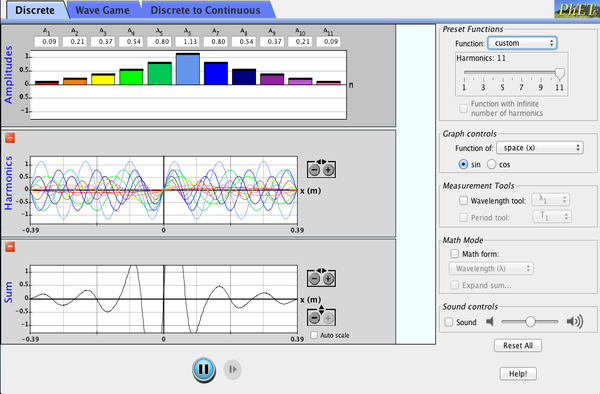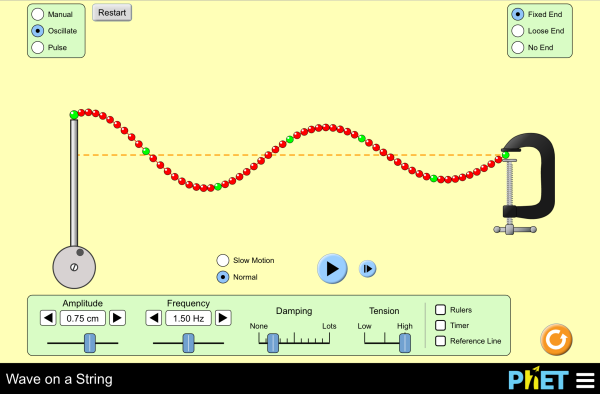Oscillatory and Wave Phenomena
Phys 218, Spring 2021
Resources and Demos Page





Hugel 020
Physics Department
Lafayette College
730 High St.
Easton, PA 18042
Phone: (610) 330-5207
Email: thomasbd@lafayette.edu






Other Phys 218 Course Pages
- Course Web Page
- Course Moodle
Physics References
- Supplementary materials site
for Waves and Oscillations, by Walter Fox Smith.
- Lecture notes: Slightly Disturbed: Oscillations, Waves, and the Mathematics Behind Them, by Brooks Thomas.
Mathematics References
- Mathematical Methods in the Physical Sciences, 3rd Ed., by Mary L. Boas.
- Mathematical Methods for Physicists, 7th Ed., by George B. Arfken, Hans J. Weber, and
Frank E. Harris.
- Wolfram MathWorld: An online mathematics reference from the makers of Mathematica.
- List of Trigonometric Identities: A Wikipedia page which lists a variety of basic trig identities.
Programming References
- Mathematica
- Python
- Anaconda Download Page: Page from which you can download the Anaconda distribution of Python. The Python 3.6 version of Anaconda will be the "official" distribution we'll be using both in the lecture and lab sections of this course.
- The Python Tutorial: A tutorial on programming in the Python language from the official Python website.
- Matplotlib Site: The official site for matplotlib, the plotting library that I recommend using for creating plots in Python. The site includes links to official and unofficial documentation, examples, and tutorials.
Video Demos
- Simple Harmonic Oscillator
- Spray-Paint Oscillator:
A can of spray paint attached to a pair of springs oscillates up and down and traces out a sine wave on a roll of
paper.
- Pendulum Waves:
A set of (uncoupled) simple pendulums with different lengths (and therefore different characteristic frequencies of oscillation) are arranged in a line and set oscillating back and forth with the same initial amplitude.
- Damped Harmonic Motion
- Laminar and Turbulent Flow:
The this video includes a nice demonstration of the transition from laminar to turbulent flow that occurs when as speed of an object relative to the fluid around it increases. In this case, a jet of
water tined with ink, which is used as a tracer of the fluid flow in the water, flows into a stream of moving water in a pipe. As the speed of the water relative to the walls of the pipe increases, the flow becomes turbulent.
- Reversible Flow:
Three drops of food coloring injected into in a highly viscous medium (in this case, corn syrup) are "stirred" into the medium by turning a crank. However, because the viscosity of the medium is extremely high, the flow is laminar and the system returns to its initial state when the crank is turned the other direction.
- Magnetic Damping:
Demonstration showing the underdamped, overdamped, and critically damped regimes for the harmonic motion of a pendulum consisting of a ruler with a magnet attached to the free end. The motion of the pendulum is damped by eddy currents induced in a nearby metal plate. The distance between the plate and the magnet is adjusted in order to vary the damping.
- Driven Oscillations and Resonance
- Driven Mechanical Oscillator:
A mass on a spring is atached to a curved rod which is moved up and down by an electric motor. The amplitude of oscillation is dramatically larger when the motor drives the rod at the resonant frequency of the system.
- Resonant Breaking of a Wine Glass:
A classic demonstration in which a sound wave with a frequency at resonance with one of the normal modes of vibration of a crystal wine glass drives the oscillation of that mode until the glass breaks.
-
Resonant Tuning Forks: Demonstrating resonance behavior and beat frequencies using a pair of tuning forks.
- Resonant RLC Circuit:
A variable capacitor, large solenoid, and a 200 W light bulb are connected in series to an 120 V AC power supply. The inductance of the solenoid can be varied by adjusting the position of an iron core inside it (or removing the core altogether), and the capacitance can be varied by flipping a set of switches. The inductance and capacitance are varied. When the natural frequency of this LRC circuit is adjusted so that it is in resonance with the driving frequency supplied by the power supply, the current is maximized and the light bulb glows brightly.
- Non-Linear Systems and Chaos
- Double Pendulum:
Demonstration of the charotic behavior that can arise in a coupled double-pendulum system.
- Coupled Oscillations and Normal Modes
- Coupled Air Carts:
Several demonstrations involving various numbers of carts coupled together by springs on an air track.
- Mode Shapes for Multiple Degree-of-Freedom Oscillators:
Denomstration of the normal modes for the transverse oscillations of a sets of up to four masses coupled together by springs.
- Modes of a Bridge:
A bunch of people excite various standing-wave modes of a wooden bridge by jumping, sidling back and forth, etc.
- Chladni Plates of Different Shapes:
Patterns of sand on several Chladni plates of different shapes are created using a violin bow. When each plate vibrates at a frequency associated with one of its normal modes of vibration, the sand collects at the nodes, where the plate doesn't move, thus providing an visual representation of the mode.
- Chladni Plates:
Patterns of colored salt on a Chladni plate are created using a mechanical vibrator, the frequency of which is constantly being increased. When the frequency come into resonance with one of the normal modes of vibration of the plate, the pattern changes.
- Tuned Mass Damper:
An informational video which includes demonstrations illustrating the physics behind a device known as a tuned mass damper, which is often installed in tall buildings to reduce swaying in response to wind or earthquakes. The device is essentially a damped oscillator (in the case shown in the video, a pendulum) which is coupled to the building and tuned to its resonant frequency of oscillation. Note that the "damping ratio" ζ that the narrator mentions is just another way of expressing the same information encapsulated by the quality factor Q for the oscillator. In particular, it's defined by the relation ζ = 1/(2Q).
- Liquid Column Damper:
Demonstration of a liquid column damper, a shock-absorbing device similar to a tuned mass damper, but which uses the motion of liquid in a column rather than the motion of a mechanical pendulum to provide damping.
- Dispersion
- Acoustic Dispersion:
This educational video illustrates some of the consequences to which the dispersion of sound waves gives rise, including the strange noises that one hears when skipping rocks across the surface of an icy lake and the sound effect that was created to accompany blaster fire in the Star Wars films.
PhET Interactive Simulations
- Fourier Analysis
- Fourier: Making Waves

- Waves
- Wave on a String










